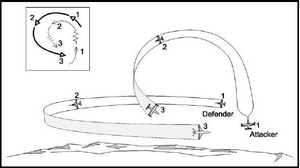The high Yo-Yo is a very effective maneuver, and very difficult to counter. The maneuver is used to slow the approach of the fast moving attacker while conserving the airspeed energy. The maneuver is performed by reducing the angle at which the aircraft is banking during a turn, and pulling back on the stick, bringing the fighter up into a new plane of travel. The attacker then rolls into a steeper pitch turn, climbing above the defender. The trade-off between airspeed and altitude provides the fighter with a burst of increased maneuverability. This allows the attacker to make a smaller turn, correcting an overshoot, and to pull in behind the defender. Then, by returning to the defender's plane, the attacker restores the lost speed while maintaining energy.[1] [2] [3]
High Yo-Yo Defense
To prevent an overshoot, an attacker in lead pursuit may need to correct with an out-of-plane maneuver. If the lateral separation is excessively high, the attacker will probably use a displacement roll. However, if the lateral separation is low enough, the attacker will likely use a high Yo-Yo. The high Yo-Yo defense can be a good tactic in these situations. The maneuver is performed when the attacker rolls away from the turn to begin the correction. The defender will begin to relax the turn by easing off of the stick, called "unloading", which causes both turn radius and speed to increase, restoring the fighter's lost energy. If the defender maintains the same angle of bank, the subtle maneuver will be very difficult for the attacker to spot. When the attacker completes the out-of-plane maneuver, the defending fighter has regained some of its energy. This allows the defender to, once again, turn harder into the attack, regaining an angular advantage over the higher energy attacker. If the attacker is surprised by the maneuver, a high Yo-Yo defense might even cause an overshoot.[4] [5]
- ↑ Figure 10-14 Perch Position Archived December 23, 2010, at the Wayback Machine, Flight Training Instruction
- ↑ Sick's ACM School: Maneuvers Explained Archived August 31, 2009, at the Wayback Machine. 352ndfightergroup.com. Retrieved on 2010-10-23.
- ↑ Shaw, Robert (1985). Fighter combat : tactics and maneuvering Annapolis, Md: Naval Institute Press. ISBN 978-0-87021-059-4. pp. 71–73, 294
- ↑ High Yo Yo Defense, Flight Training Instruction
- ↑ Shaw, Robert (1985). Fighter combat : tactics and maneuvering Annapolis, Md: Naval Institute Press. ISBN 978-0-87021-059-4. pp. 137
